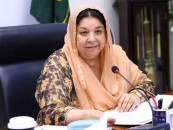Flood-prone areas identified: Disaster-hit areas face fresh flood threat
Villages in Sindh, Punjab and Azad Kashmir already under water.

Flood-prone areas identified: Disaster-hit areas face fresh flood threat
As the monsoon cycle begins in Pakistan, areas across the country have been identified as being at risk of being hit by floods once again – some have already been inundated.
The Provincial Disaster Management Authority (PDMA) has stated that floods have been predicted to occur as early as July 15 if the water level in River Swat rises.
The PDMA has identified areas such as Kalam, Balakot, Uthror, Bahrain and Mankyal in Upper Swat at high risk of being inundated. These areas were hit by floods last year and will become inaccessible if the floods recur this year. An estimated displacement of some 20,000 people is expected in Charsadda and 25,000 people in Nowshera this year. Earlier, the National Disaster Management Authority (NDMA) held a press conference revealing that approximately 20 million people are likely to be affected if faced with a disaster identical to last year’s.
Although Chairman NDMA Zafar Qadir reflected confidence in the preparedness of the government to respond to the challenges, at the same time he was uncertain about the scale of the disaster.
Floods begin, yet again
The PDMA also revealed that areas in Muzafarghar and Layyah which were one of the worst-hit locations last year are already experiencing early flooding.
According to officials from Oxfam, floods have already hit Ghorki disctrict in Sindh where more than 100 villages have been inundated.
In many areas of the country, floods have already forced communities to evacuate and have drowned crops for the second year running.
Officials have stated that residents of the Ghotki district have started migrating to safer havens, while crops have been damaged for the second time.
“One year on after the mega floods of 2010, Pakistan and its people are still struggling. With the onset on monsoon rains, the rebuilding of damaged dykes and embankments is still not finished. That puts vulnerable communities at risk of fresh flooding,” Javeria Afzal, programme manager for disaster risk reduction and climate change, Oxfam, told The Express Tribune.
In Punjab, there is currently three to four feet of water standing in the villages, while floods have also cut off many villages in Rangpur.
Broken structures stand as reminders of what happened last year in district Layyah – one of the many villages in Punjab that has still not fully recovered from last year’s floods. Oxfam field officers said that some families are still living in shelters and have no means of earning a livelihood. Moreover, the people of this village were not warned of the floods last year, and therefore, lost most of their belongings.
Published in The Express Tribune, July 15th, 2011.



















COMMENTS
Comments are moderated and generally will be posted if they are on-topic and not abusive.
For more information, please see our Comments FAQ